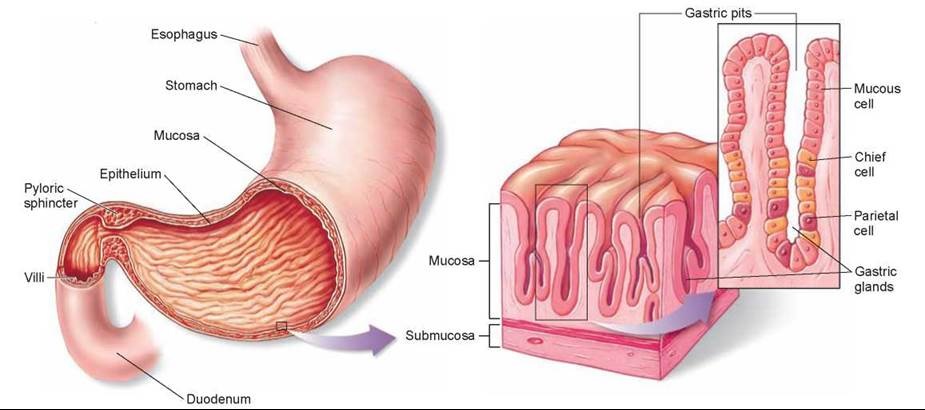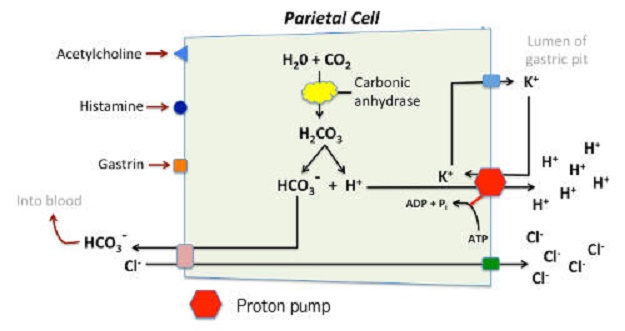A stomach ulcer is a sore in the stomach lining caused by irritation over a period of time. Something weakens and breaks the protective lining of the stomach allowing stomach acid to act on the wound. Usually due to stress, the stomach cannot produce enough mucus to protect the stomach lining, resulting in the soft tissue below the lining becoming exposed, thus allowing gastric juices (strong stomach acid and pepsin enzymes) to come into direct contact with the wound. This irritates the soft tissue causing gastritis (inflammation of the stomach lining), until eventually, the constant irritation causes a sore, called an ulcer. The body tries hard to repair the damage, replacing epithelial cells every 2-3 days.
A stomach ulcer is a type of peptic ulcer (incl. gastric, duodenal and esophageal ulcers). Peptic ulcers can occur in the lower esophagus, stomach, or the upper small intestine, called the duodenum. About 80-90% of peptic ulcers are in the duodenum (since the stomach mucosal glands have usually produced and emptied out too much acid chyme to be neutralized by the pancreatic juices). The next most common ulcers are in the stomach
The most common cause of tissue damage in peptic ulcers is the Helicobacter Pylori(H. Pylori) bacteria. Previously known as Campylobacter pylori, this gram-negative, helically-shaped microaerophile can colonize in the gastric epithelium. After establishing its residence, it weakens the protective mucous coating of the stomach (and also intestinal duodenum), thus allowing stomach acid access to the sensitive lining beneath. Both the acid and the bacteria irritate the lining and cause a sore, or ulcer.
Some relevant stomach anatomy 101 |
|---|
The stomach lining (gastric mucosa/mucus membrane)This 1 mm thick, velvety smooth, protective mucus membrane lines the stomach. It contains mucus secreting glands and columnar epithelial cells.Secreting gastric glands are located at the bottom of deep depressions in the stomach wall, called gastric pits. The gastric glands contain 2 types of secretory cells --- parietal cells, which secrete hydrochloric acid (HCl) and bicarbonate (HCO3-) and chief cells, which secrete pepsinogen, which requires a very acidic ( low pH) to be activated into its active form pepsin, the enzyme for digesting protein in the stomach. Stomach lining integrity and repair. TGF-alpha produced by gastric epithelial cells stimulate epithelial cell proliferation. TGF-alpha also enhances mucus secretion and inhibits stomach acid production. Other cytokines such as fibroblast growth factor and hepatocyte growth factor have been shown to enhance healing of gastrointestinal ulcers in experimental models. 
Gastric / Stomach acidPredominately composed of hydrochloric acid (HCl). Also water, electrolytes (sodium, potassium, calcium, phosphate, sulfate, and bicarbonate), and other organic substances, such as mucus, enzymes (pepsins), and protein. Has a pH of about 1.5 - 3.5 Primary purpose is for partial digestion of proteins in the stomach. Unravels proteins and activates digestive pepsin enzymes to break down (hydrolize) the long chains of amino acids in food proteins (peptides) into shorter polypeptide chains and so make their complete digestion easier in the small intestine. Sufficient HCl keeps the pepsin enzyme working at its best. Of interest, some absorption of water, alcohol and weakly acidic drugs occurs in the stomach. E.g. Aspirin is a weakly acidic drug, and being mostly un-ionised in the acid stomach, is more easily absorbed by the stomach mucosal cells via diffusion. However, overall, most absorption takes place in the small intestine. ~20% of water and alcohol is absorbed from the stomach. Gastric gland parietal and chief cellsParietal cellsParietal cells produce hydrochloric Acid (HCl), bicarbonate (HCO3-), intrinsic factor (needed for red blood cell maturation and B12 absorption) and most of the water in gastric juice. HCl production is controlled by the hormone GASTRIN to produce HCl only when pH goes above ~1.5, and slows due to negative feedback around a pH of 2. GASTRIN increases in response to gastric distention (via vagus nerve) and insufficent acidity when food enters stomach. Parietal cells produce an average 1.35 liters of HCl / day to create a stomach acid average pH of ~2.5 (i.e. ~250,000 times more acidic than blood). Parietal cells secrete hydrogen ions to be combined with chlorine ions to form HCl, which drains into the bottom of the gland and passes into the stomach by ATP-powered magnesium-dependent proton pumps (H+/K- ATPase). HISTAMINE and ACETYLCHOLINE also control HCl production Parietal cells produce bicarbonate ions (HCO3-) in exchange for chlorine ions (Cl-) used for HCl production. After eating, bicarbonate is secreted into the blood by gastric mucusal cells resulting in a slight elevation of blood pH known as the "alkaline tide". This process maintains a balanced pH inside the parietal cell. 
Prostaglandins (cell-localized, hormone-like substances present in most all tissues / body fluids) and PPIs omeprazole (Losec™ or Prilosec™) and lansoprazole (Prevacid™) inhibit acid secretion by the parietal cells. Prostaglandins are members of the eicosonoid family of lipid molecules. In particular, the prostaglandins PGE2 and PGI2 (prostacyclin) are well recognized cell-protectors. Their other protective modus operandi is that they stimulate mucosal mucus and bicarbonate secretion, increase mucosal blood flow, and limit back diffusion of acid into the stomach lining epithelium. Chief cellsChief cells produce pepsinogen (converted to the pepsin enzyme for digesting protein). Like HCl, production is also controlled by food consumption (via the vagus nerve) and the hormones/neurotransmitters: GASTRIN, HISTAMINE and ACETYLCHOLINE. Gastric mucosa and mucus cells (foveolar cells)Foveolar cells produce mucus to protect the stomach lining (gastric mucosa) from corrosive stomach acid. Located in the neck of the gastric pits, these surface cells cover the entire gastric mucosa to provide a thick mucus layer, which both lubricates the lining to help food masses travel through the stomach more easily and protects against damage. This protective mechanism prevents the lining from being digested by its own protein "breakdown" enzymes, also aided by the parietal cell production of bicarbonate, which is secreted by gastric mucus cells to result in a neutral pH close to the lining. Mucus is a slimy material composed of mainly mucin cells and inorganic salts suspended in water. Abundant carbohydrates on mucin molecules bind to bacteria, which helps to prevent them colonizing in the epithelial lining. Gastric mucosal lining also contains acid-resistant lipoproteins Parietal cell bicarbonate production brings bicarbonate to the surface for secretion by gastric mucous secreting cells. |